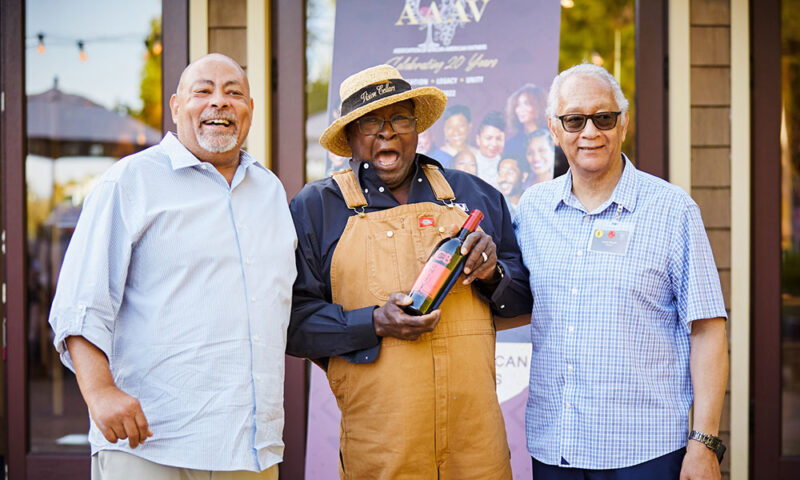
Always More Room in the Vineyard: How Collaboration Pushes a Diversity-Minded Association Forward
The Association of African American Vintners, which turns 20 this year, has grown significantly by leaning into a collaborative approach—one fostered by its founders, its industry, and by its open-tent approach to DEI and membership.
Let’s say you start in a specific line of work, and while your entrepreneurial spirit leads to success, you notice something missing—people who look like you who share your passion and expertise.
How do you solve that problem? In the case of winemaker Mac McDonald, you start an association that aims to build upon the community that is there.
Since its formation two decades ago, the Association of African American Vintners has leaned into that original mission in earnest. AAAV came into existence in 2002, after McDonald, the founder of Vision Cellars, realized that he was one of the few Black winemakers in the field.
McDonald, along with fellow cofounders Vance Sharp and Dr. Ernest Bates, came together to form a sounding board for those looking to get into the field and to generate ideas. AAAV has also worked to build interest in wine among Black consumers.
“Our focus was on how to make good wine, how to market it, and on understanding the costs,” McDonald said. “We were able to move everyone forward in the industry by sharing our experiences, especially the things we learned from mentors.”
A Sense of “Coopetition”
The collaborative nature of the association was natural, thanks to two key factors. First, winemaking has traditionally been a regional field, with many winemakers based in the Sonoma Valley of California, where McDonald built his label. This geographic concentration fostered an environment where members could discuss factors like technique and execution in a collective setting.
But the other factor, according to Phil Long, current AAAV president and owner of Longevity Wines, is a shared willingness to make the industry thrive through a combination of cooperation and competition.
“They truly lean into the term ‘coopetition,’” Long said. “Representing such a small sector of the wine trade, it’s important that our organizational culture is rooted in community because we go further together.”
In that spirit, the organization works to elevate the field in general—for example, creating an online storefront for consumers to buy wine brands produced by AAAV members.
There’s still plenty of room for the space to evolve. According to data provided by Long, less than 1 percent of American winemakers are Black, with the association aware of around 70 Black-owned wine brands in the country.
With that in mind, the organization is working to expand the field for future vintners. Last year alone, AAAV offered $46,000 in scholarships, helping to build a path for individuals of color to join the field.
“Our mission is to ultimately create diversity within the wine industry. We do that by increasing awareness, education, and collaboration of Black winemakers within the wine industry,” Long said. “I think knowing your goals and working strategically on how to get there are the keys.”
A Stance Against Exclusion
One of the more interesting things that AAAV has done in recent years is expand its member base beyond Black vintners. Membership is now open to any company or individual that supports the group’s broader goals of diversity, equity, and inclusion.
“Let us all remember why we are at the place we are—it is the result of exclusion,” Long said. “This is not the path forward.”
Long, who became president of the association in 2020, noted that the organization saw value in bringing in companies that supported the group’s broader cause. Per one recent estimate, 15 percent of AAAV’s members are not people of color.
“You do not have to be a Black winemaker to believe in and support diversity and inclusion in the wine industry,” Long continued. “This isn’t a Black quality, it’s a human quality. We all need to be good humans and work together to get to a place where there is no exclusion.”
Long pointed to the public outcry after the death of George Floyd as underlining this point, noting that collective progress continues to grow in importance in society at large as well as within the organization.
“We need all the voices we can get if we are ever going to get to that place of equality,” he added.
Leaning Into Growth
While AAAV has been around for two decades, signs indicate that the organization is now hitting its stride. Since June 2020, the association has seen its membership levels grow by 500 percent, as well as an increased level of donations from the public.
That has created new avenues to reach people who are interested in the association’s cause, according to AAAV Executive Director Angela McCrae.
“One of the unexpected learnings from AAAV’s rapid growth in membership over the past two years is how wine entrepreneurship is growing rapidly outside of the vineyard,” said McCrae, who is also the founder of the wine-focused media company UnCorked & Cultured. “Many of our new members are educators, retailers, marketers, and media experts. We expect this diverse membership will be an asset in helping our members to gain the resources they need to advance their careers.”
AAAV leaders, including president Phil Long, founder Mac McDonald, and vice president and treasurer Louis Garcia, meet at the association’s 20th Anniversary Symposium in May.






Comments